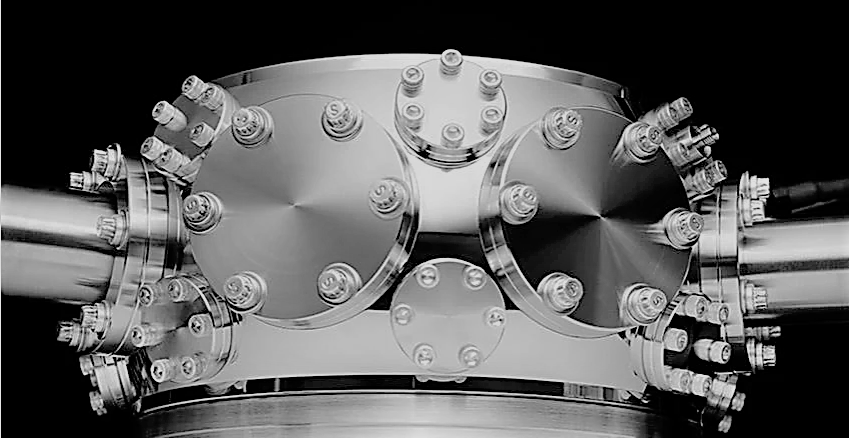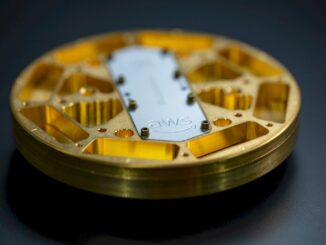
The quantum computing effort at Honeywell appears to be heating up. Over the last several months, the company has announced a series of new developments in its trapped ion quantum computer research, which suggests that it is close to launching its first system.
If you weren’t aware that Honeywell had a quantum computing program, you are not alone. While the occasional terse news statement about this effort is posted on the company’s quantum solutions page, the tech giant has otherwise been rather tight-lipped about its plans in this area. A request from us for more information was met with: “We don’t have anything further to add on this front.”
Since October of last year, Honeywell has been offering these smaller tidbits on a regular basis. In November, the company revealed it had started testing its first-generation qubit devices, followed in January by the claim that it had “demonstrated record-breaking high fidelity quantum operations” on its trapped-ion qubits. In March, it announced it had demonstrated “parallel operating zones” on the device, which it believes will provide faster execution and more flexible qubit connectivity.
Despite the recent flurry of activity, the quantum computing effort at Honeywell has been going on underneath the covers for at least five years. Its roots go back to 2014, when Honeywell was one of the participants in a program for the Intelligence Advanced Research Projects Activity (IARPA) that involved research into trapped ions. After the IARPA program wrapped up, the company went on to build six different quantum computing devices based on some of that early work.
The use of the trapped ion technology puts Honeywell in rare company, since the most visible companies pursuing quantum computing, including IBM, Google, Intel, and Rigetti, are basing their hardware on semiconductor technology. IonQ, which we profiled in April, is the only other company we know of that is employing trapped ions for its qubits. Like Honeywell, IonQ is using ytterbium (Yb) atoms for its ion traps.
Honeywell’s attraction to trapped ion technology mirrors that of IonQ, namely that these atomic level structures are totally uniform, naturally resistant to error-producing noise, and can be connected to one another in different configurations at runtime. While this technology doesn’t have the decades-long history and proven scalability of semiconductors, at this point, it offers the most interesting alternative for solid-state quantum computing.
As of last year, the company was evaluating different architectures, including one-dimensional arrays of ions and a more scalable design using two-dimensional arrays. The latter removes the limits in the number of qubits that can strung together in a linear arrangement.
Fidelities for single qubits on Honeywell’s prototypes are reported to be as high as 99.997 percent, which the company claims is the best in the business. (For what it’s worth, IonQ says it has achieved 99.97 percent single-qubit fidelities.). According to Tony Uttley, who heads up the Honeywell Quantum Solutions group, the high quality of its qubits can be attributed to its expertise in atomic physics, optics and precision control systems. However, since Honeywell has yet to report results for two-qubit fidelity, which is considered to be the better metric, it’s difficult to make any definitive comparisons with technology from IonQ or any of the other quantum computing entrants.
Uttley and his team, which is made up of about 100 physicists, engineers, and technicians, are singularly focused on designing and developing trapped-ion quantum computers for the commercial market. Although no product roadmap has been publicly offered, he expects to have its first system up and running before the end of 2019. The plan is to make that a testbed system, which will be accessible to researchers, companies, and physicists.
“We believe that quantum computing will eventually have a significant impact on all multi-industry companies,” says Uttley. “When that happens, those companies will need to figure out how to respond to either take advantage of or mitigate the business changes stemming from the technology. Our approach is to influence how quantum computing evolves and shape the opportunity for Honeywell and our customers.”





Which Honeywell location is working on this project?
Great work Honeywell. Well written article.
I think it’s located in Minnesota.
“IBM, Google, Intel, and Rigetti, are basing their hardware on semiconductor technology”
They use superconducting qubits, not semiconductor.
Intel is also working with semiconductor spin qubit led by Prof. Lieven Vandersypen at QuTech.
Quantum computing has been “right around the corner” for twenty – thirty years now.
Which will get here first Nuclear Fusion or Quantum Computing!
And really NextPlatform your sister publication [The Register] has really begun to degrade in its quality of reporting with regards to the CPU market place. And namely the x86 based CPU market place where one x86 ISA based CPU marker can hardly be the only source of x86 CPU parts to the OEMs(PCs and laptops) what with the other x86 CPU maker’s competitive offerings appearing over the last few years.
Any glaring omissions concerning the x86 CPU market place where there has been and is currently only 2 major players such as omitting one of those 2 players when discussing any CPU market effects caused by shortages of CPU parts from only one x86 maker is beyond disingenuous. As if PC/Laptop OEMs have only one source of x86 based CPU parts! So maybe that’s more incentives related from one of the 2 x86 CPU makers to the PC/Laptop OEMs from that one x86 maker that has currently a majority market share position. And we all know how that turned out even with the fines being little more than a small cost of doing nefarious business.
Biting the hand my patoot!
I worked on this for a while at Honeywell. The project is probably way underfunded and not really on track to be a useful reality. They will most likely fund it for a few years, try to get lots of press, then it will fizzle out and they will lay everyone off. They ripped me off with fake verbal promises…way too cheap to actually keep the talent around they would need to pull something like this off. They should stick to air filters and small sensor assemblies.
Better research guys 😉 Alpine Quantum Technologies and Quantum Factory from Austria and Germany!
Since quantum computing is done at the molecular level why are they not using mass spectrometer readings to measure the state of the molecules when they calculate certain equations it should be able to repeat those results as if trying to determine whats in the molecule (as in its chemical composition) during each equation?